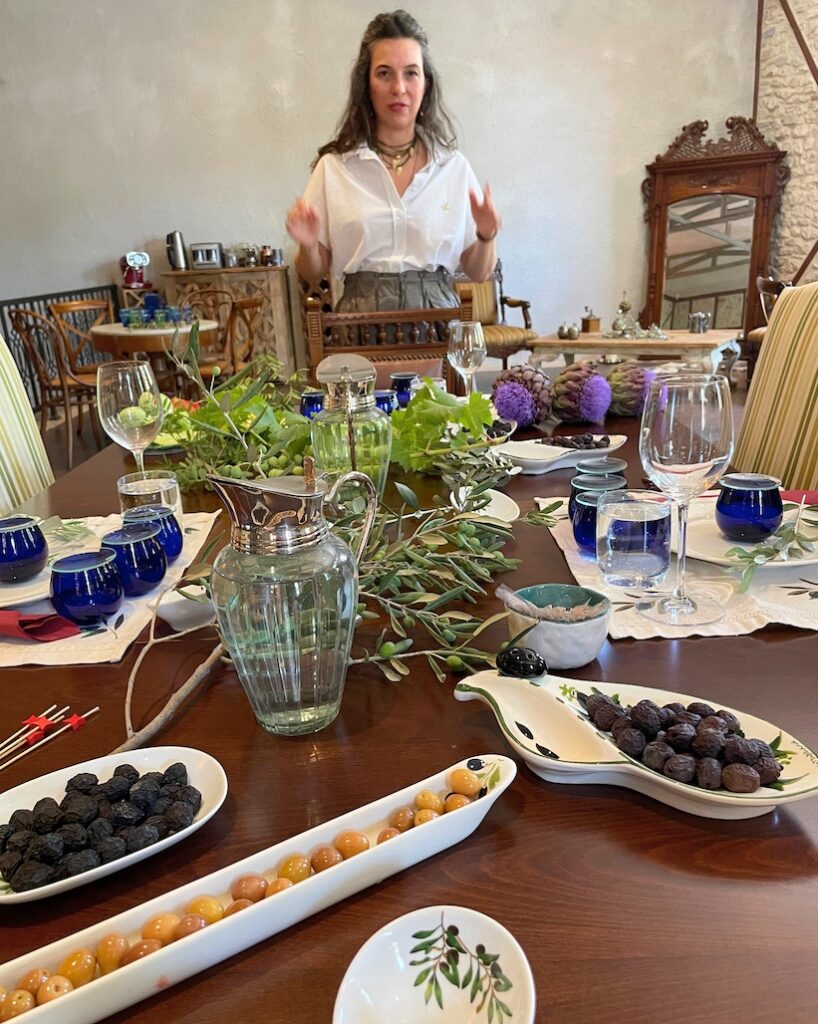
Oleologist Pelin Omuroğlu hosts 90-minute olive oil tasting sessions that cost $55 per person. The experience is much like those offered by Napa Valley vintners in California. Photo by Barbara Noe Kennedy
By Barbara Noe Kennedy
In a beautifully restored olive oil mill in Urla—on Turkey’s Aegean coast, west of Ephesus and its now-crowded ancient streets—oleologist Pelin Omuroğlu swirls a golden-green liquid in a blue, tulip-shaped glass, its color concealed, its character revealed through scent and texture alone.
“Smell first,” Omuroğlu instructs. “Then slurp—pull in air through your mouth and take quick breaths. Now swallow. Feel the burn?”
Hints of red apple, almond, and peppery bite unfold—not just flavors, but expressions of time, place, and tradition. For visitors, it’s a revelation. For Omuroğlu, it’s a calling.
“When people taste, they understand,” she says. “With the tongue, with the nose. They understand the culture.”
A second-generation olive farmer, she is part of a growing movement to reclaim Turkey’s rightful place on the global olive oil map. It is a story that predates Italy’s bottled elegance and Spain’s industrial scale.
Redrawing the Olive Oil Map
Today, Turkey ranks as the world’s largest producer of table olives and one of the top five for olive oil production—alongside Spain, Italy, Tunisia, and Greece—yet few consumers realize it. Much of its oil is exported in bulk to countries like Italy and Spain, where it’s blended, bottled, and sold under foreign labels, leaving Turkey’s olive oil legacy largely invisible on international shelves. “You think you’re buying Spanish or Italian oil, but it’s a blend that includes Turkish oil,” Omuroğlu says.
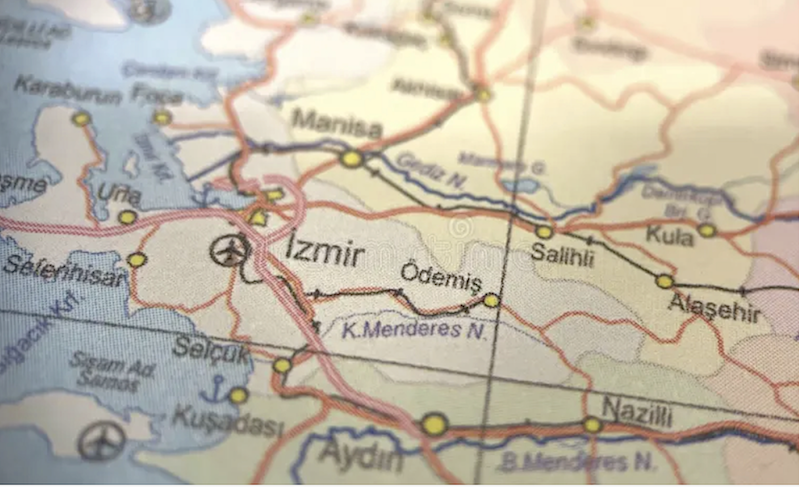
Turkey’s historic olive oil producing region extends west from Izmir toward Urla and the Urla-Karaburun-Çeşme Peninsula
But along the Urla-Karaburun-Çeşme Peninsula, extending westward into the Aegean Sea, a different story is unfolding—one that puts local growers and ancient groves back in the spotlight. Rather than remaining a hidden supplier, the region is stepping forward with its own narrative, inviting visitors to experience its olive oil culture firsthand.
Turkey’s Hidden Olive Oil Legacy
Long before Italy and Spain became olive oil powerhouses, what is now Turkey was already laying the foundations of this ancient craft. Archaeological finds—from charred olive pits and clay tablets to wooden pressing tools recovered from Bronze Age tombs—point to early olive domestication along the Turkey-Syria border nearly 6,000 years ago.
By the 6th century B.C., port cities like Klazomenai—just a stone’s throw from Urla—were exporting olive oil across the Aegean, making this stretch of coast one of the Mediterranean’s earliest trade hubs for liquid gold.
For Omuroğlu, learning this history made her mission even clearer. “Klazomenai was one of 12 major Ionian cities that formed the Ionian League,” she explains. Many cities maintained olive oil mills, reflecting a sophisticated production network for the time. Excavations at Klazomenai’s ancient harbor uncovered one of the earliest and best-preserved olive oil processing facilities ever found, reinforcing the city’s role as a major center of olive oil production in antiquity.
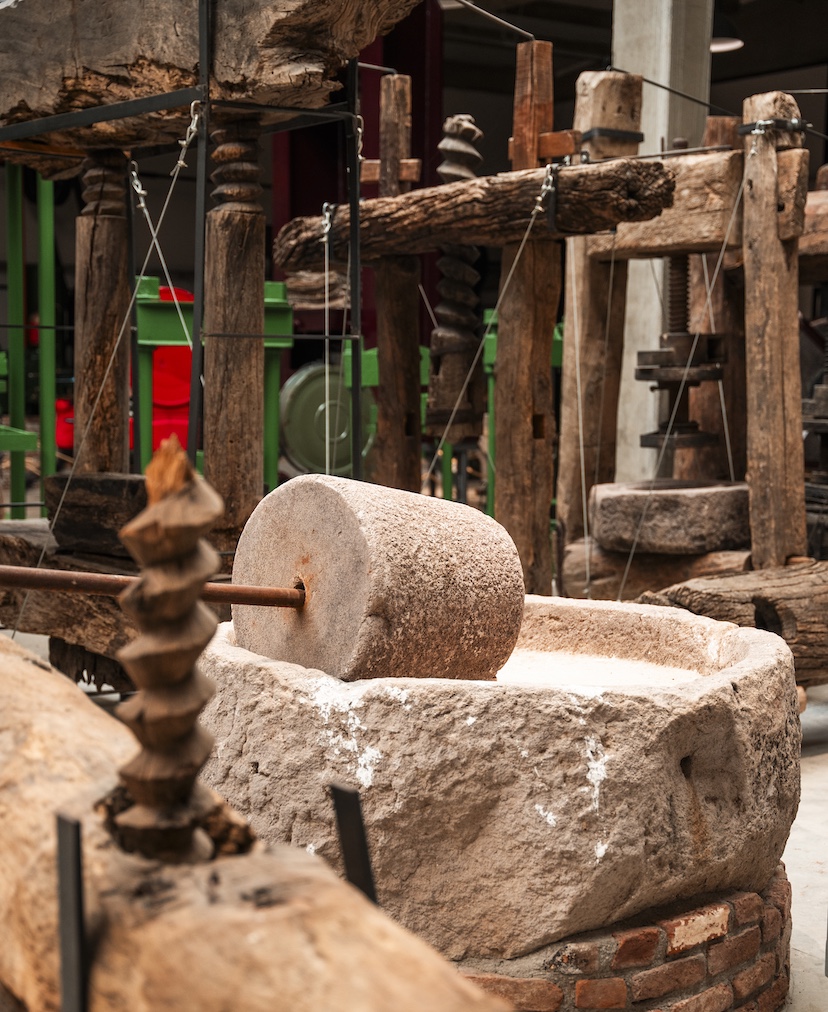
This traditional olive oil press is on display at the Köstem Olive Oil Museum. The circular stone in the middle is the millstone, used to crush olives into a paste. The carved stone basin beneath it held the olives during crushing. In the background, you can see old wooden screw presses–once used to apply pressure to the crushed olive paste, extracting olive oil. Photo courtesy of Go Türkiye
“When I learned that,” Omuroğlu says, “I knew we had a responsibility to keep it going. We have to make the best quality olive oil in respect to that heritage.” In 1998[1], she and her parents planted their first olive trees, laying the groundwork for what would become Olivurla more than a decade later. By the early 2010s, she had officially founded the brand, determined to produce high-quality oils that honor Turkey’s heritage.
A New Generation of Producers
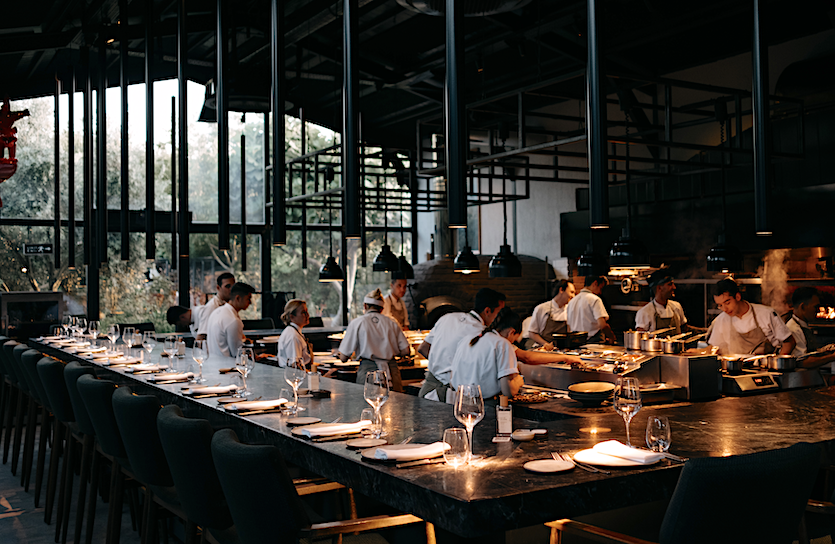
Cooks assigned to the Chef’s Table at the Od Urla restaurant must start preparing food early if they are to satisfy the crush of evening diners. Photo courtesy of the Osman Sezener Group
Since then, she’s worked to shift perceptions. At her tasting room, visitors learn to recognize varietals and about harvest traditions, part of the country’s growing oleotourism scene, a form of agritourism that immerses travelers in the craft and culture of olive oil. Across Urla, small-batch producers have emerged, bringing fresh energy to age-old groves. “We have a lot of starter projects for olives and olive oils,” she says. “Now there are so many producers. A lot of the younger generation is interested.”
She’s also working with local restaurants. “They used to use olive oil that should not be consumed at all,” she says. “They used to think that musty, defective oil was somehow natural. They had very wrong ideas about what quality meant.”
Local chefs listened, and the region is now experiencing a culinary renaissance that’s drawing international attention. Chef Osman Sezener’s Michelin-starred Od Urla restaurant stands at the center of this revival.
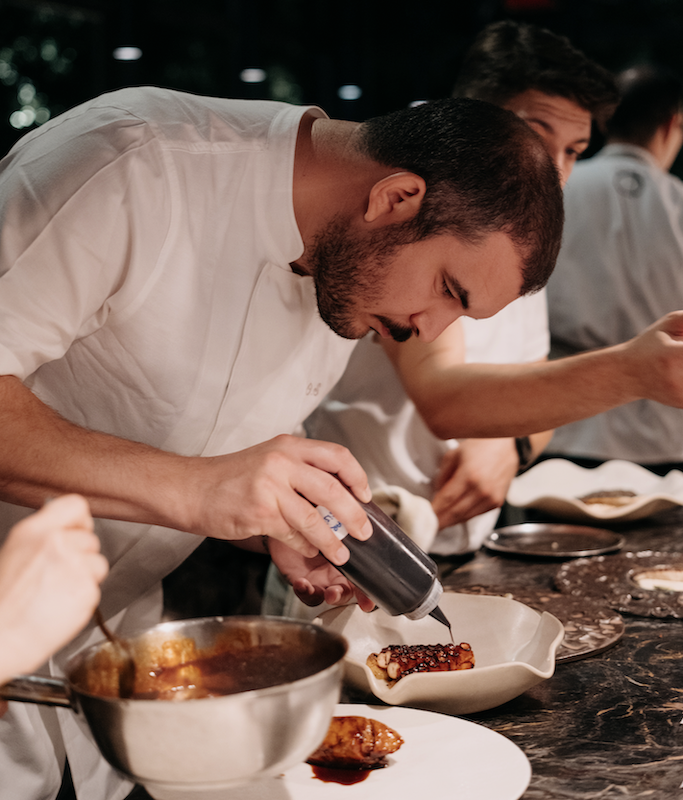
Michelin-starred Chef Osman Sezener at the Od Urla restaurant in the city of Urla in Izmir Province stands at the forefront of Turkey’s gastronomic revival. Photo courtest of the Osman Sezener Group
From Local Roots to Global Recognition
What started as a local crusade has grown into a national effort to reclaim Turkey’s olive oil legacy. In 2023, that movement gained international recognition through UNESCO’s acknowledgment of Turkey’s traditional olive cultivation as part of the world’s intangible cultural heritage. “The application included a lot of information about how we harvest, what we eat, how we behave, and the traditional ways of harvesting,” Omuroğlu says. The designation honors Turkey’s harvest-time rituals, folkloric songs, community feasts, and even theatrical performances, all held between November and January when the scent of crushed olives fills the cool air.
One enduring practice is the başak—a tradition in which the last olives clinging to the treetops are gathered and donated to the poorest in the community, either to use or sell to local mills.
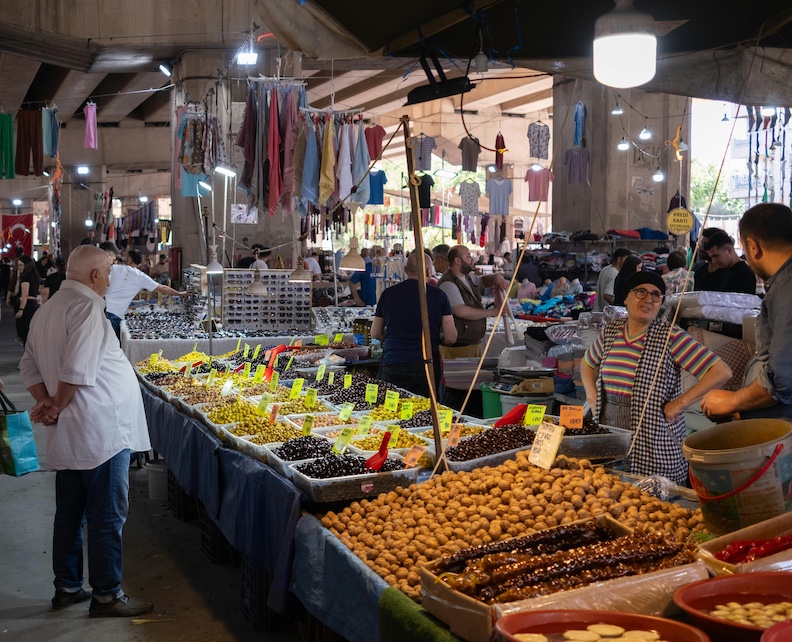
The olive market in Izmir is one of the Aegean city’s most active tourism destinations. Photo by Doğan Alpaslan Demir
Another is the hurma olive celebration—hurma olives are unique to the region, ripening naturally on the branch and developing their signature sweetness through a naturally occurring microbial process influenced by coastal humidity and winds. During harvest time in November, women gathering these olives by hand pause at midday for a simple, time-honored meal: tarhana soup, sourdough bread, red onion, and fresh hurma olives. “It’s a scene so emblematic that painters have immortalized this living, breathing part of our culture,” Omuroğlu says.
The Olive Road Experience
For travelers wanting to experience this living history firsthand, the Olive Road offers the perfect path. Launched in 2015, it connects trees aged between 300 and 2000 years with traditional workshops, working mills, scenic views, and historic pressing sites.
One of the most interesting stops, near Zeytinler Village, is Köstem Olive Oil, the world’s largest olive oil museum. The sleek 20,000-square-meter complex—roughly the size of three soccer fields—displays ancient amphorae, oil lamps, and a 1,000-year-old olive tree, alongside interpretive exhibits that chart the spread of olive oil culture across the Mediterranean.
As you enter, you’re greeted by a life-size reproduction of the olive oil workshop unearthed at the nearby ancient site of Klazomenai, showcasing its three-compartment oil separation system —a significant technological advancement in ancient times that laid the groundwork for modern olive oil separation methods.
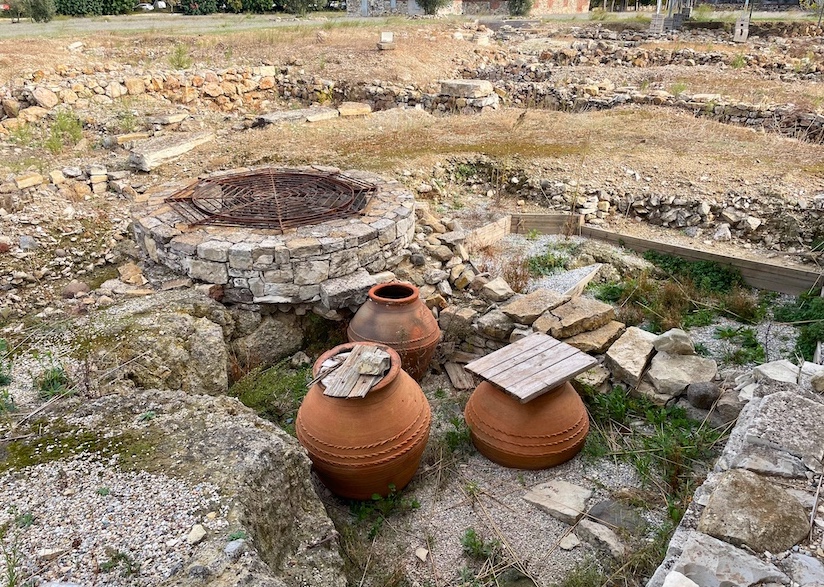
The active archaeological site nearby the Klazomenai Ancient City is from where olive oil 2,600 years ago was shipped throughout the Aegean region in terra cotta amphorae. Photo by Barbara Noe Kennedy
Where History Lives
But for those wanting to stand where history truly happened, the Klazomenai Ancient City offers a quieter, more authentic experience. Just a short, tree-shaded drive away, the archaeological site marks the very spot where 6th-century B.C. olive oil was once pressed for export across the Aegean. It’s not a fancy place—there’s no visitor center, only a few panels that describe the history. But here, adjacent to the archaeologist’s worksite where the original press was discovered, stands a full-scale replica beneath a shelter, complete with stone presses, basins, and amphorae.
Amid jasmine, wild thyme, and salty sea breezes, you sense the genius of a people who made oil a cornerstone of life. While olive oil’s origins likely reach deeper into the eastern Mediterranean, this place offers tangible proof that Turkey wasn’t merely present in olive oil’s history; it helped shape it.
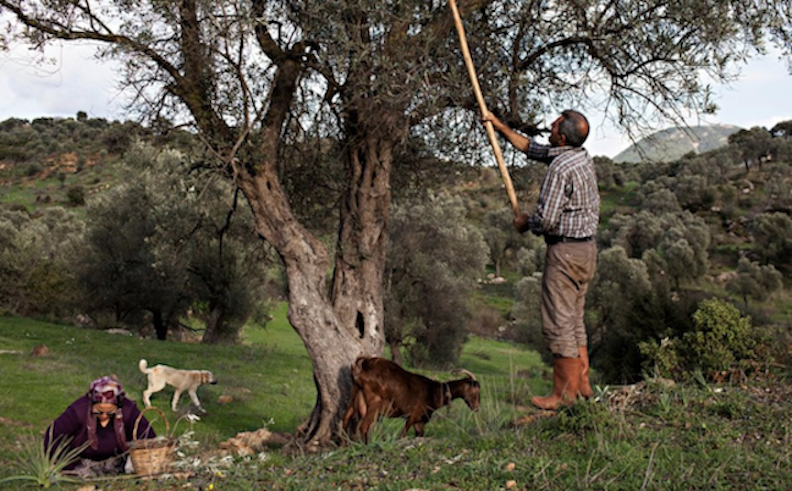
Small family farms, many headed by a new generation of agronomists, are at the forefront of Turkey’s olive oil resurgence. Photo courtesty of GoTürkiye
For Omuroğlu and others like her, this legacy isn’t a relic. It lives—through every tasting, every grafted branch, and every story shared beneath the olive trees. “When people taste olive oil at one of my tastings, it sparks something,” she says. “A sense of where it comes from, and why that matters.”
A single sip becomes part of a larger story—rooted in the groves of Urla, carried forward by new producers, and putting Turkey back on the global olive oil map.![]()
Barbara Noe Kennedy, a longtime senior editor at National Geographic Travel, now pursues the craft of travel writing. Her work has appeared in Travel & Leisure, Fodor’s Travel, Lonely Planet, The Washington Post, Outside and AFAR. This is her first story for the East-West News Service.
[1] https://www.oliveoiltimes.com/business/just-when-olive-oil-tourism-was-trending-in-turkey-the-pandemic-hit/97030

